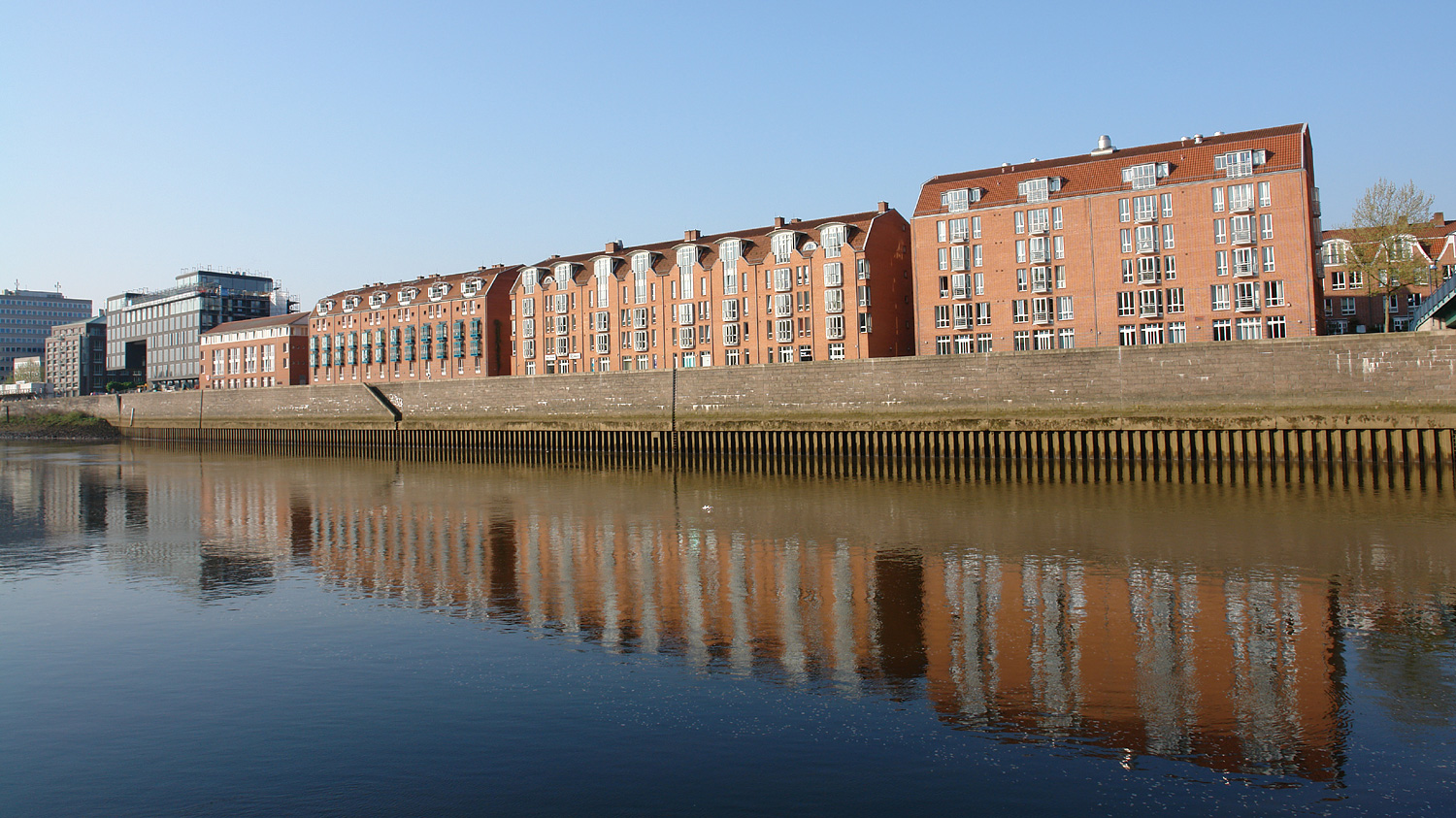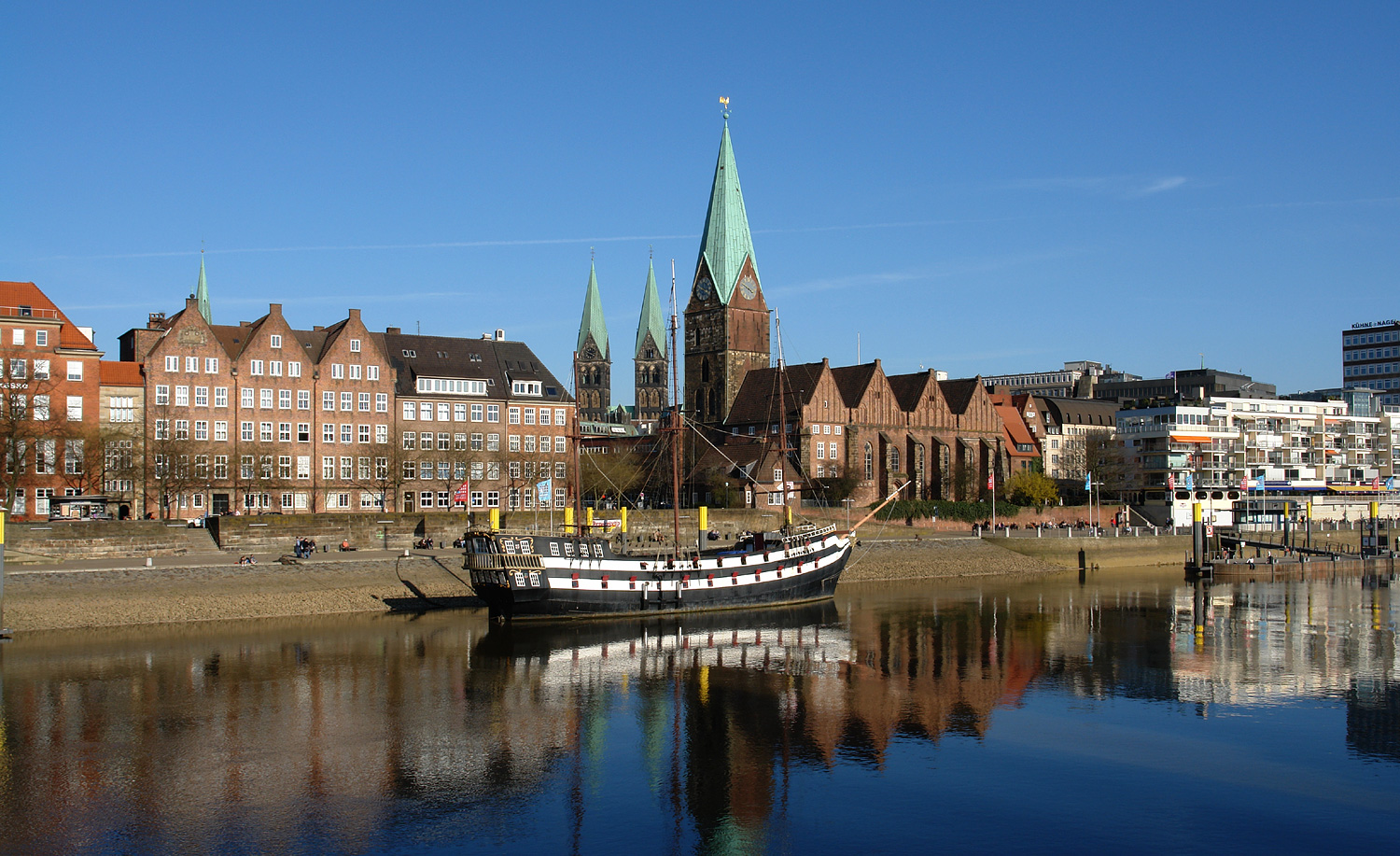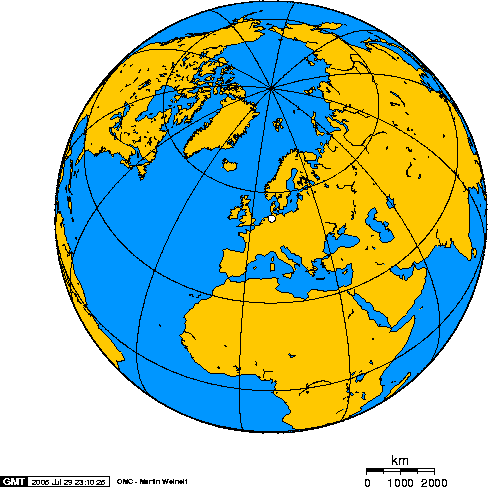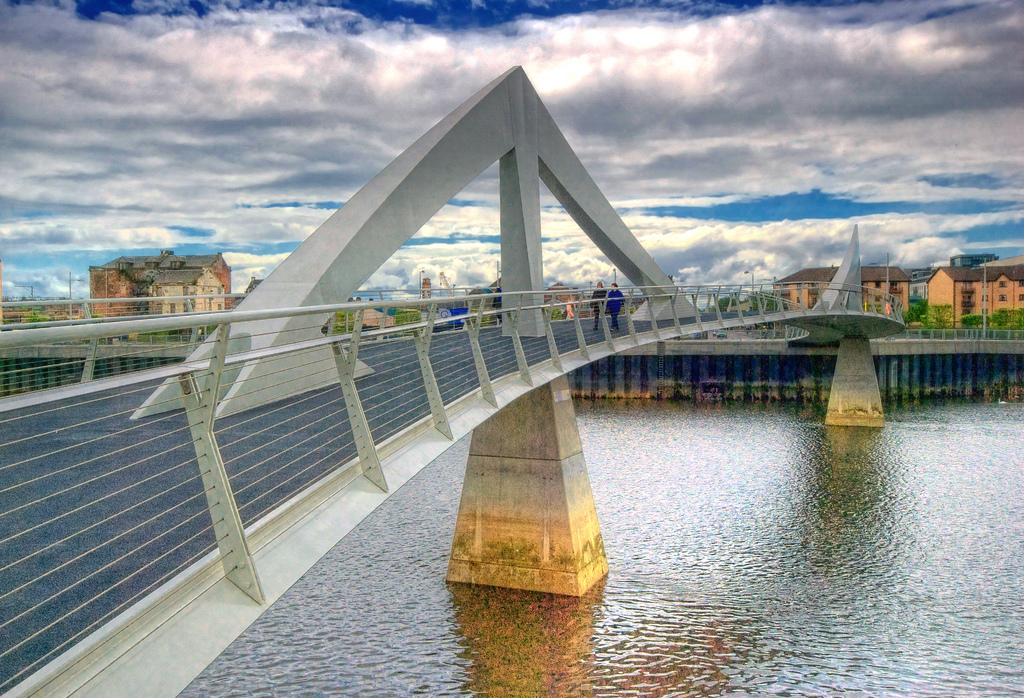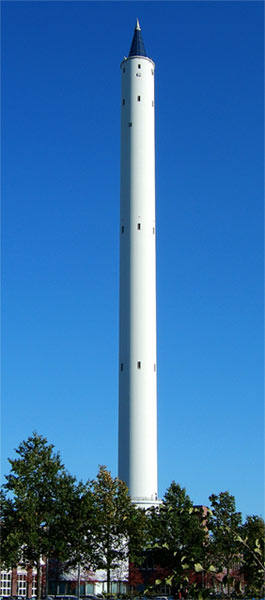|
Teerhof
The Teerhof is a peninsula between the Weser, River Weser and the Kleine Weser and Werdersee, Kleine Weser, opposite the city centre of Bremen, Germany. It was first mentioned in 1624 as "Theerhof" when it was the northernmost part of an island. Today it consists mainly of residential buildings and the Weserburg modern art museum. History The name Teerhof means "tarring yard" as it was here ship hulls and ropes were once tarred for the local shipyard. Up to the end of the 19th century, mixed industrial and residential developments led to a widely varying collection of buildings. By the 1930s, the Teerhof was made up of storehouses, small production facilities, a coffee factory and housing. All the buildings were almost completely Bombing of Bremen in World War II, destroyed during the Second World War. The Weserburg coffee factory which was also seriously damaged was repaired and reopened in 1949. When it closed in 1973, the building was sold to the city and was used for various ... [...More Info...] [...Related Items...] OR: [Wikipedia] [Google] [Baidu] |
Weserburg
The Weserburg is a modern art museum in Bremen, Germany. Opened in 1991, it is located on the Teerhof peninsula next to the River Weser in an old factory building which was almost completely destroyed in the Second World War. Originally known as "New Museum Weserburg Bremen" (''Neues Museum Weserburg Bremen''), it was Europe's first "collectors' museum", in that it conserves no permanent collection but mounts changing exhibition of private collections. It is one of the largest modern art museum spaces in Germany. History In 1893, a cigarette factory was opened by Ad. Hagens & Co. on the Teerburg Peninsula in the middle of the Weser. Known as Hagensburg, the building's two Neogothic gate towers contrasted with the surrounding warehouses. After the Schilling Brothers (''Gebrüder Schilling'') acquired the building in 1923 for a coffee factory, the name was changed to Weserburg. Almost totally destroyed in the Second World War, the building was repaired and reopened in 1949. When t ... [...More Info...] [...Related Items...] OR: [Wikipedia] [Google] [Baidu] |
Schlachte
The Schlachte is a promenade along the east bank of the River Weser in the old town of Bremen in the north of Germany. Once one of the city's harbours, it is now popular for its restaurants, beer gardens and river boats. Etymology ''Schlachte'' is a Low German word for a river bank reinforced with wooden piles driven in by the action of hammering (cf. German ''eingeschlagenen''). The word ''slait'' was used as early as 1250 to refer to the river bank in Bremen. History In 1247, following authorisation from Archbishop Gerhard II, the area between St Martini's Church and Zweite Schlachtpforte (a street meaning "second quayside gate") was settled by local citizens and traders. In 1250, those privileged to operate water mills were required to maintain the wooden piles used to reinforce the river bank. In the 13th century, both the Schlachte and the Balge were used as harbours for wood (used as firewood) and limestone although the banks of the Balge soon became Bremen's main port. ... [...More Info...] [...Related Items...] OR: [Wikipedia] [Google] [Baidu] |
Bremen
Bremen (Low German also: ''Breem'' or ''Bräm''), officially the City Municipality of Bremen (, ), is the capital of the States of Germany, German state of the Bremen (state), Free Hanseatic City of Bremen (), a two-city-state consisting of the cities of Bremen and Bremerhaven. With about 577,000 inhabitants, the Hanseatic League, Hanseatic city is the List of cities in Germany by population, 11th-largest city of Germany and the second-largest city in Northern Germany after Hamburg. Bremen is the largest city on the River Weser, the longest river flowing entirely in Germany, lying some upstream from its River mouth, mouth into the North Sea at Bremerhaven, and is completely surrounded by the state of Lower Saxony. Bremen is the centre of the Northwest Metropolitan Region, which also includes the cities of Oldenburg (city), Oldenburg and Bremerhaven, and has a population of around 2.8 million people. Bremen is contiguous with the Lower Saxon towns of Delmenhorst, Stuhr, Achim, Wey ... [...More Info...] [...Related Items...] OR: [Wikipedia] [Google] [Baidu] |
Beluga Shipping
Beluga Shipping was a German heavy-lift shipping company in the Hanseatic city of Bremen. It was a world market leader in heavy-lift shipping and also highly innovative in related fields. As such, it was the first to equip ships of its fleet with SkySails that can reduce fuel consumption by up to 5%, and was the first company to send a heavy-lift ship from Europe to Asia along the Northern Sea Route through the Arctic Ocean rather than through the Suez Canal. The company was declared insolvent in March 2011, affecting 670 employees. History Beluga Shipping was founded in Bremen in December 1995 by entrepreneur Niels Stolberg, initially as a cargo operator. In 1998, the company acquired its first vessel, the multipurpose heavy-lift carrier MV ''Beluga Obsession''. In 1999, the company built its first new vessel, the MV ''Werder Bremen.'' Beluga Shipping grew significantly during the following years. By May 2010, 69 multipurpose heavy-lift carriers were in service for the co ... [...More Info...] [...Related Items...] OR: [Wikipedia] [Google] [Baidu] |
Weser
The Weser () is a river of Lower Saxony in north-west Germany. It begins at Hannoversch Münden through the confluence of the Werra and Fulda. It passes through the Hanseatic city of Bremen. Its mouth is further north against the ports of Bremerhaven and Nordenham. The latter is on the Butjadingen Peninsula. It then merges into the North Sea The North Sea lies between Great Britain, Denmark, Norway, Germany, the Netherlands, Belgium, and France. A sea on the European continental shelf, it connects to the Atlantic Ocean through the English Channel in the south and the Norwegian Se ... via two highly Saline water, saline, Estuary, estuarine mouths. It connects to the canal network running east–west across the North German Plain. The river, when combined with the Werra (a dialectal form of ''Weser''), is long and thus, the longest river entirely situated within Germany (the Main (river), Main, however, is the longest if the Weser-Werra are considered separate). ... [...More Info...] [...Related Items...] OR: [Wikipedia] [Google] [Baidu] |
Kleine Weser And Werdersee
Until 1968 the Kleine Weser and the Werdersee were part of the river Weser in Bremen, Germany. See also *List of rivers of Bremen A list of rivers of the state Bremen (state), Bremen, Germany: B *Balge (river), Balge G *Geeste (river), Geeste K *Kleine Weser and Werdersee L *Lesum *Lune (Weser), Lune O *Ochtum S *Schönebecker Aue V *Varreler Bäke W *Weser *West ... Rivers of Bremen (state) 0KleineWeser Rivers of Germany {{Bremen-river-stub ... [...More Info...] [...Related Items...] OR: [Wikipedia] [Google] [Baidu] |
Bremer Teerhof 1640-41 - Brema Von Matthäus Merian Dem Älteren
Bremer may refer to: People *Bremer (surname) *Bremer Ehrler (1914–2013), American politician * Bremer (born 1997), Brazilian footballer Places ;Australia *Bremer Bay, Western Australia * Bremer Marine Park * Bremer Island *Bremer River (other) ;USA * Bremer, Iowa, an unincorporated community *Bremer County, Iowa *Bremers Lake, a lake in McLeod County, Minnesota Other uses *Bremer SV, a German football club *ATSV 1860 Bremen, a former German football club, also known as Bremer SC *The Bremer Institute of TAFE, an Australian TAFE institute *Bremer 25, an American sailboat design *Bremer Straßenbahn AG, German public transport provider *Bremer Vulkan, a German shipbuilding company *Bremer wall, used for protection by American forces in Iraq *The Report of the National Commission on Terrorism, also known as the Bremer Commission *Stadion an der Bremer Brücke, a German sports stadium See also * Brehmer * Bremmer (other) * Bremen (other) Bremen is a ci ... [...More Info...] [...Related Items...] OR: [Wikipedia] [Google] [Baidu] |
Bombing Of Bremen In World War II
The Bombing of Bremen in World War II by the British Royal Air Force (RAF) and US Eighth Air Force involved both area bombing and, as capacity improved, more targeted raids upon the city's military-industrial facilities. These included the shipyards of Vulkan, AG Weser and Atlas Werke, the Valentin submarine pens, oil refineries and the aircraft works of Focke-Wulf. Early RAF raids on Bremen beginning in May 1940 had sought out these industrial and military targets but the efforts proved costly and, given limited navigation and target-location capabilities, impractical. From September 1941 the RAF switched to night-time "area bombing". In the spring of 1942 new directives from Bomber Command under Air Marshal Arthur Harris formalised the change of strategy. Drawing lessons from the German Blitz on Britain, Bomber Command concluded that rather than being "collateral damage", broader bombing raids which also destroyed residential districts served the legitimate purpose of w ... [...More Info...] [...Related Items...] OR: [Wikipedia] [Google] [Baidu] |
Dissing & Weitling
Dissing+Weitling is an architecture and design practice in Copenhagen, Denmark. The founders and namesakes Hans Dissing and Otto Weitling founded the firm upon the death of Arne Jacobsen as a continuation of his office where both had been key employees. Dissing+Weitling is particularly notable for the design of a great number of bridges around the world, ranging from small pedestrian and bicycle bridges to some of the longest bridges in the world, including the Danish Great Belt, Øresund Bridge and Osman Gazi Bridge. History Hans Dissing and Otto Weitling were key employees at Arne Jacobsen's office and they founded Dissing+Weitling in 1971 upon his death to continue and complete his unfinished projects. These included a city hall in Mainz, Germany, which was also extended by Dissing+Weitling in 2008, a holiday resort on the north German island of Fehmarn, the Danish Embassy in London. In 1972, the firm won competitions for the IBM Centre in Hamburg and the Kunstsammlung Nordrhe ... [...More Info...] [...Related Items...] OR: [Wikipedia] [Google] [Baidu] |
Bremen University
The University of Bremen () is a public university in Bremen, Germany, with approximately 18,400 students from 117 countries. Its 12 faculties offer more than 100 degree programs. The University of Bremen has been among the top 50 European research universities for more than 50 years and focuses its research on 5 high-profile areas. It is one of 11 institutions which were successful in the category "Institutional Strategies" of the Excellence Initiative launched by the Federal Government and the Federal States in 2012. The university was also successful in the categories "Graduate Schools" and "Clusters of Excellence" of the initiative. Some of the paths that were taken in the early days of the university, also referred to as the "Bremen model", have since become characteristics of modern universities, such as interdisciplinary, explorative learning, social relevance to practice-oriented project studies which enjoy a high reputation in the academic world as well as in business a ... [...More Info...] [...Related Items...] OR: [Wikipedia] [Google] [Baidu] |
Populated Places In Bremen (city)
Population is a set of humans or other organisms in a given region or area. Governments conduct a census to quantify the resident population size within a given jurisdiction. The term is also applied to non-human animals, microorganisms, and plants, and has specific uses within such fields as ecology and genetics. Etymology The word ''population'' is derived from the Late Latin ''populatio'' (a people, a multitude), which itself is derived from the Latin word ''populus'' (a people). Use of the term Social sciences In sociology and population geography, population refers to a group of human beings with some predefined feature in common, such as location, race, ethnicity, nationality, or religion. Ecology In ecology, a population is a group of organisms of the same species which inhabit the same geographical area and are capable of interbreeding. The area of a sexual population is the area where interbreeding is possible between any opposite-sex pair within the area ... [...More Info...] [...Related Items...] OR: [Wikipedia] [Google] [Baidu] |
